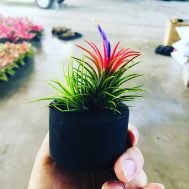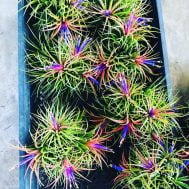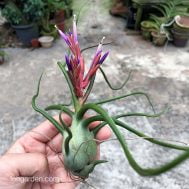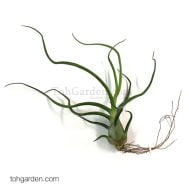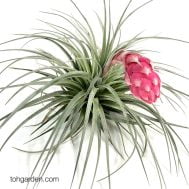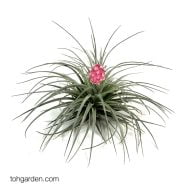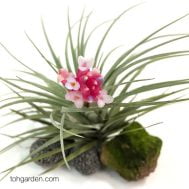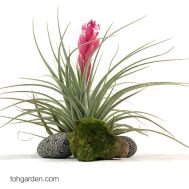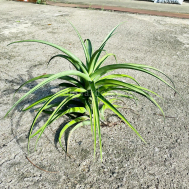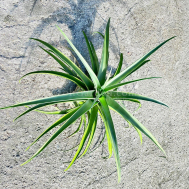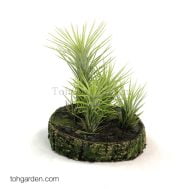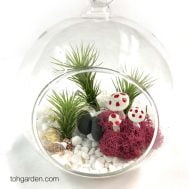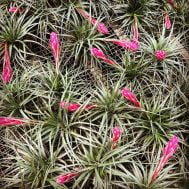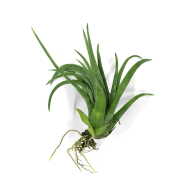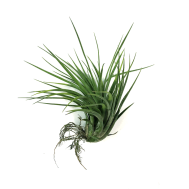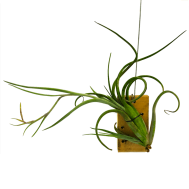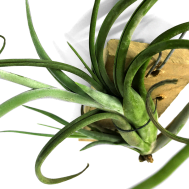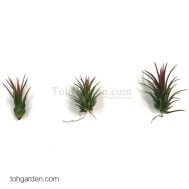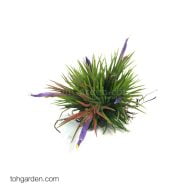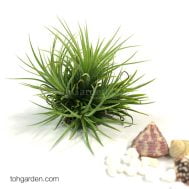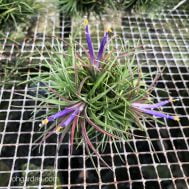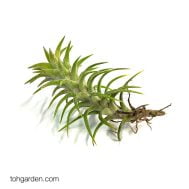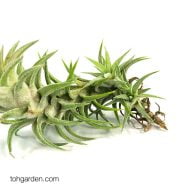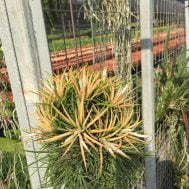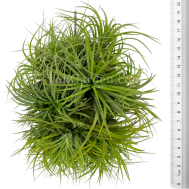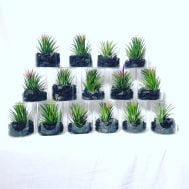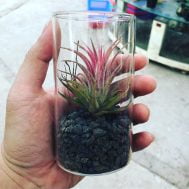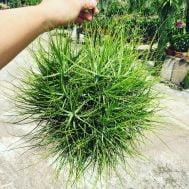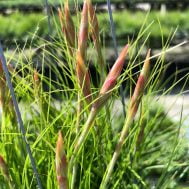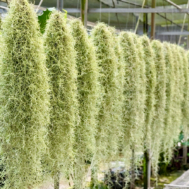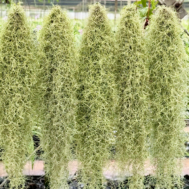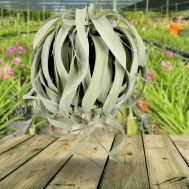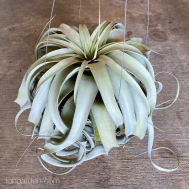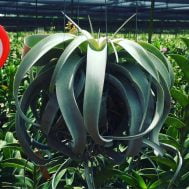Tillandsia is a genus of around 650 species of evergreen, perennial flowering plants in the Bromeliaceae family, native to the woods, mountains, and deserts of northern Mexico and the southern United States, Mesoamerica and the Caribbean, and Argentina. Their silvery leaves are coated with specialized cells (trichomes) capable of rapidly absorbing water that collects on them.
They are also known as airplants because of their natural proclivity to cling to any surfaces they can find: telephone wires, tree branches, barks, bare rocks, and so on. This dispersal is aided by their light seeds and silky parachute. The majority of Tillandsia species are epiphytes, which means they live on plants. Some are aerophytes, which have no roots and thrive on changing desert soil. Because of their epiphytic lifestyle, these plants will not grow in soil but will instead survive on the branches of trees, in deserts, and on other substrates that will not be soaked with water for an extended period of time.
Tillandisa Ionantha Rubra
$10.00 $10.90 (Including GST)Tillandsia Bulbosa ‘Medusa’
Price range: $20.00 through $25.00Tillandsia Cotton Candy
Price range: $12.00 through $25.00Tillandsia Cotton Candy
$12.00 $13.08 (Including GST)Tillandsia flexuosa
$25.00 $27.25 (Including GST)Tillandsia Funckiana
$15.00 $16.35 (Including GST)Tillandsia Houston
$15.00 $16.35 (Including GST)Tillandsia hybrid
$10.00 $10.90 (Including GST)Tillandsia hybrid
$10.00 $10.90 (Including GST)Tillandsia intermedia
$10.00 $10.90 (Including GST)Tillandsia Ionantha “Fuego”
$5.00 $5.45 (Including GST)Tillandsia Ionantha “Rubra”
Price range: $7.00 through $17.00Tillandsia ionantha “vanhyningii”
$15.00 $16.35 (Including GST)Tillandsia Ionantha “Druid” Clump
Price range: $20.00 through $35.00Tillandsia Ionantha Ball Clump
$40.00 $43.60 (Including GST)Tillandsia Ionantha in Glass Vial
$15.00 $16.35 (Including GST)Tillandsia schiedeana “Minor”
Price range: $15.00 through $150.00tillandsia usneoides
$25.00 $27.25 (Including GST)Tillandsia Xerographica (Jumbo Size)
$150.00 $163.50 (Including GST)Tillandsia xerographica XXL
$150.00 $163.50 (Including GST)
Tillandsia are perennial herbaceous plants with a wide range of physiological and morphological characteristics, making this a complex genus. Species with natural habitats ranging from epiphytic to saxicolous exhibit adaptations such as root systems intended to attach to other plants or substrates and modified trichomes for water and nutrient absorption. Some of the species, like the vast majority of Bromeliaceae, develop as funnel bromeliads with a compressed stem axis. The leaves then form rosettes and cover the lowest regions of the leaves, producing a funnel for collecting water.
These leaf rosettes, which are a common morphological feature of Tillandsia species, gather nutrients and water. The flowers are generally brilliant and colorful in color, with blooms or inflorescences grown on a stalk or stalks. The color of the flower varies significantly; red, yellow, purple, and pink blooms appear in this species, as do multicolored flowers. Pollinators are drawn to the vivid hues. When an air plant blooms, the leaves may change color, enticing pollinators. Hermaphrodite flowers have three petals and a double perianth. The three free sepals are sharp and symmetrical. The seeds, like the dandelion, have a “parachute.”
Moths, hummingbirds, and, more lately, bats are common pollinators of this genus. After flowering, the mature Tillandsia pup dies back and numerous young pups will surface at the base of the mother plants. Pups may also form on the flowering spike of some species like the Tillandsia flexuosa.
Spanish moss (T. usneoides), a species that grows atop tree limbs, has organically developed in different habitats such as equatorial tropical rain forests, high elevation Andes highlands, rock dwelling (saxicolous) areas, and Louisiana wetlands. However, there are certain organisms that live lithophytically, or on rocks (but also roofs and even telephone wires).
The green species that claim a cool-humid environment dwell primarily in the shadow plains or at lower elevations of forests. In contrast, virtually all gray species dwell in low-precipitation, high-humidity regions. They love direct sunlight and may thus be found in the higher floors of the forests, on rocks, or (rarely) on the ground. Many of the gray species are epiphytes (plants that grow on other plants). Some species are xeromorphic to varying degrees.
Tillandsias, like other bromeliads, may reproduce via pollination and seed production. Because Tillandsia plants are not self-fertile, the pollen must originate from another plant of the same species. Depending on the species, it might take months or years for Tillandsia to blossom. After flowering, the plant dies and produces offsets.
Thinner-leafed variants thrive in wet locations, whereas thicker-leafed varieties grow in drought-prone areas. Most species collect moisture and nutrients from rain, dew, dust, decaying leaves, and insect matter through their leaves, which are assisted by structures known as trichomes. Air plants are becoming increasingly popular as low-maintenance houseplants. Because of their small root system and other adaptations, they do not need to be watered frequently, no more than four times a week, allowing the plant to completely dry before watering again.
The amount of light required varies according to the species; in general, air plants with silver dusting and rigid leaves require more sunshine than air plants with softer foliage. They usually require a bright light. Outside in the summer, they prefer the mild shade of a tree during the warmest hours. Plants are frequently found mounted, in terrariums, or just in seashells as ornamental items. Watering is done by the leaves in the form of frequent sprays or brief soaking of the plant in a container full of water for so-called “aerial” species (the majority of common species in culture except Tillandsia cyanea), that is, those whose roots have been transformed into crampons with no absorption power. It is very necessary to use non-calcareous water. If available, rainwater collected from the flow of a mossy or green roof is ideal for this purpose.
Tillandsia species photosynthesize using the CAM cycle, in which they cover their stomata during the day to avoid water loss and open them at night to fix carbon dioxide and release oxygen.
Because they are epiphytes, this helps them to conserve water. They lack a functioning root system and instead absorb small amounts of water via their leaves via little structures known as trichomes. Tillandsia species also take nutrients from trash and dust in the air.
Any Tillandsia root system has grown to function as a frail stabilizing framework to grasp the surface they grow on. The green assimilation tissue behind the suction scales becomes visible again after they have been soaked in water, and the plant is thus “greened.” The plant can now absorb more light. The plants turn white as they dry in the sun. Plants without roots can collect fog droplets as well as precipitation, allowing them to meet their water requirements.
Tillandsia makes up more than one-third of the vascular plants in a tropical forest. Their contribution to the carrying capacity of the ecosystem permits terrestrial species such as earthworms to survive in the treetops.
Temperature is not important, with a temperature range of 10 to 32 °C. In a tropical humid climate, most Tillandsia thrives quickly and healthily. Frost hardiness varies by species. T. usneoides, for example, can withstand nighttime frosts as low as 10 °C. The optimal growing temperature for most species is between 20 and 25 °C, with a minimum of 10 °C and a high of 30 °C. Few are hardy to 10 °C, although some, generally from higher elevations, are hardy enough to endure light and short freezes and remain outside all year in moderate winter climates.

